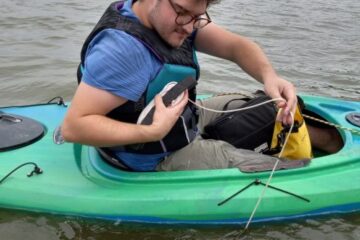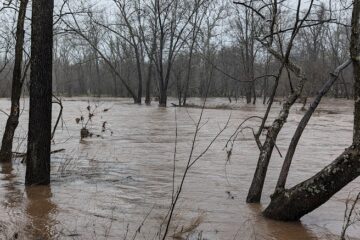We’ve seen invasive species’ negative effects in gardens, forests, preserves, and impacting farmlands from a land management perspective. But have you thought about the plants in your lakes, streams, canals, rivers, and ponds? Emerging threats of invasive species are lurking beneath the surface that can cause negative impacts such as decreased dissolved oxygen levels, clog water intakes, a refuge for mosquitos to breed, impede upon recreational activities, impacting aesthetics, and reducing property values. While there are a variety of aquatic invasive species, here are three main aquatic invasives you should be on the lookout for this summer.
Common Name: Hydrilla Scientific Name: Hydrilla verticilliata
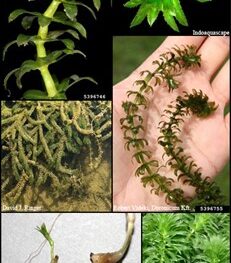 For many years botanists were not concerned about Hydrilla (Hydrilla verticilliata) becoming a threat to the Northeast. However, over the years, climate change altered those predictions. It is unclear the specific pathway in which this species came to the USA; However, we know it originated from Asia. According to documentation from the 1960s, Hydrilla was utilized in the aquarium trade in Florida. Like many other invasive species in Florida, it was likely released into the environment and took home to many ponds, lakes, and canals within the area. In the 1980s, it was confirmed in the Potomac River, and since then, through various pathways, recreational activities, wildlife, and natural storm events progressed the spread of Hydrilla throughout the Northeast. This species, often confused by the native species Common Waterweed, can be identified by the following characteristics: serrated leaves in whorls of 3-6 thin (2-4 mm wide, 6-20 mm long). Some of the Northeastern sites have been documented in New Jersey’s backyard and state neighbors, recent finds include the Delaware and Raritan Canal (NJ), the Delaware River (NJ/PA), Croton River (NY), and New Croton Reservoir (NY).
For many years botanists were not concerned about Hydrilla (Hydrilla verticilliata) becoming a threat to the Northeast. However, over the years, climate change altered those predictions. It is unclear the specific pathway in which this species came to the USA; However, we know it originated from Asia. According to documentation from the 1960s, Hydrilla was utilized in the aquarium trade in Florida. Like many other invasive species in Florida, it was likely released into the environment and took home to many ponds, lakes, and canals within the area. In the 1980s, it was confirmed in the Potomac River, and since then, through various pathways, recreational activities, wildlife, and natural storm events progressed the spread of Hydrilla throughout the Northeast. This species, often confused by the native species Common Waterweed, can be identified by the following characteristics: serrated leaves in whorls of 3-6 thin (2-4 mm wide, 6-20 mm long). Some of the Northeastern sites have been documented in New Jersey’s backyard and state neighbors, recent finds include the Delaware and Raritan Canal (NJ), the Delaware River (NJ/PA), Croton River (NY), and New Croton Reservoir (NY).
What makes this highly invasive species detrimental to the environment is its ability to replicate through multiple strategies. For example, potato-like structures, also known as tubers, at the root system can stay dormant for up to 10 years or longer in the sediment. Another strategy is through turions, a bud-like structure that appears from the plant’s stem, which will develop and fall off into the sediment to establish another plant. Lastly, a common reproductive strategy of many aquatic invasive species is fragmentation. Broken pieces of the plant can float to other water bodies, re-root, and thrive along various shorelines.
In addition to the advanced replication structures of Hydrilla, there are multiple biotypes, often referred to as strains, of Hydrilla within the USA. Historically, two biotypes have been documented in the United States being monoecious and dioecious. A third biotype identified as clade C has been discovered in the tidal Connecticut river system recently confirmed through genotyping in 2021. This serves as a significant threat to other major waterways, tidal systems, and water resources as not much information is known on this biotype yet.
Common Name: Waterwheel Scientific Name: Aldrovanda vesiculosa
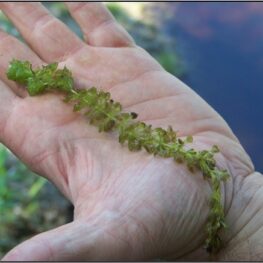
Photo Credit: USGS
A new aquatic plant species emerged in New Jersey called Waterwheel (Aldrovanda vesiculosa). This free-floating species is on the invasive species watch list in New Jersey. The Waterwheel was initially discovered in 1699 by Leonard Plukenet in India, and many years later, under observations by Charles Darwin, hypothesized the carnivorous behaviors of this species. Genetically related to the Venus flytrap, this carnivorous species feeds on zooplankton and small larval prey that venture into their traps. With old vegetation dying back as new vegetation grows from the opposite end of the strand, this species grows in acidic or lower pH environments. During the winter months, Waterwheels form turion buds that become detached from the main plant and will remain dormant at the bottom of the water until suitable conditions allow for new growth. This species is often confused with bladderwort species but can be identified by the following characteristics, 4-to-8-inch stems with leaves in a whorl around the stem and may produce a white flower protruding from the water.
This species it may be limited by water chemistry, meaning this plant’s survival rate is limited by environmental conditions- but there is a chance of adaptability. While we can only assume the negative impacts of this species, as it is unclear what ecological impacts Waterwheel will have on our water resources; monitoring this species is key to determining what consequences it may have. Read more about how this species was introduced to New Jersey and New York in the New York Times.
Common Name: Water Solider Scientific Name: Stratiotes aloides
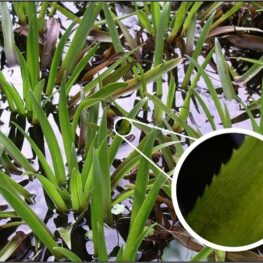
Photo Credit: Invading Species Awareness Program (Canada)
Water Solider (Stratiotes aloides) has been managed over several years in Ontario, Canada. In 2008, it was first found outside its native range in the Trent River in Ontario, Canada. Water Soldier’s current distribution in North America is known only in Ontario. Water Soldier can appear in two different forms, emergent and submergent. During the summer months, water soldier becomes buoyant at the surface and can produce white three-petal flowers mid-summer. Through various forms of reproduction, the flowers eventually will develop fleshy berries that contain up to 24 seeds, turions, and offsets that support the spread of this invasive. The rosettes are sword-shaped brittle leaves with sharp, serrated leaf margins and can reach an average of 2′ in length. It resembles the appearance of a pineapple top or aloe plant. During the fall months, this invasive becomes submerged sinking below the water’s surface where it can overwinter in a rootless state. This plant remains alive throughout the winter, even in icy conditions based on plant cell properties. This invasive species can outcompete natives, potentially altering surrounding water chemistry, impacting aquatic biota, and inhibiting recreational activities. Be sure to keep a lookout for this invasive along shorelines in your rivers, ponds, streams, and lakes.
Emily Mayer, M.S.
Watershed Scientist, Raritan Headwaters Association

